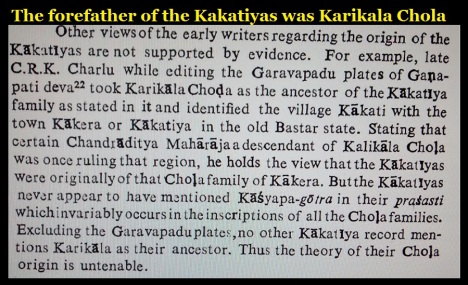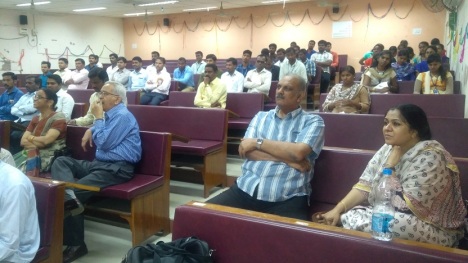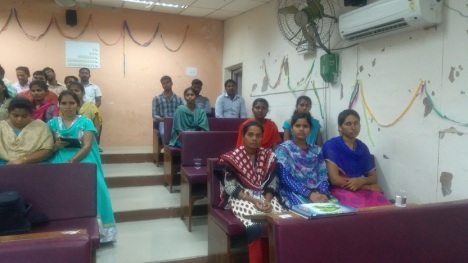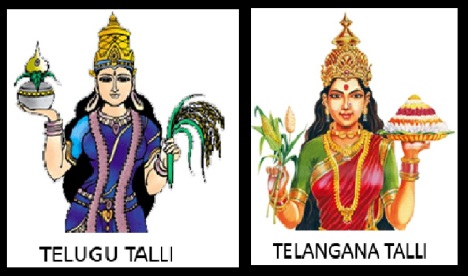“Social Formation and Regional Identity in Medieval Telangana”, the National Seminar held at the premises of the University campus on 24th, 25th March, 2017 (2)

Dr Suyakumar presenting his paper.

Audience view – LHS

Audience view – RHS.
The First Technical Session (24-03-2017): After lunch, the technical session started. In the session, the following papers were presented:
| Sl. No | Name of the paper presenter | Name of the paper presented |
| 1 | Dr Jaikrishan | Neglected history of Metallurgy |
| 2 | Dr Surya Kumar | Contemporary history gleaned through inscriptions (Telugu) |
| 3 | G. Anjaiah | Society in the Prabandhas during the period of Qutub Shahi period. |
| 4 | Dr Kanaka Ratnam | Medieval Caste system (Telugu) |
| 5 | Sri K. V. Ramakrishna Rao, IRS | Disappearance of Cholas and appearance of Kakatiyas during 13th century in the context of Social Formation and Regional Identity. |
The first paper had been much generalized manner mentioning the metallurgical advancement from IVC to the present period, covering the medieval period, giving a very few examples about the Kakatiya dynasty. He took one hour for his paper, but, most of the materials are well known taken from the works of R. Balasubramaniam, IIT, Kanpur and Dr S. Kalyana Raman[1]. The second paper presenter took two inscriptions and gave a discourse about the importance of inscriptions for interpreting history. The third one about Prabandhams, the Telugu narrative gave details about the festivals, position about the women etc. The fourth one delved upon the different castes like Gaunda, Gauda etc., during the medieval period. The last one was about the possibility of the Kakatiyas knowing the movement of the Cholas, particularly that of Rajendra who passed through Andhra, on his march to Ganges. He also pointed out as to how Kambar referred to Ganapati Rudra when he was away from the Choladesha, due to difference with him. He presented with Powerpoint giving references from the inscriptions.

K. V. Ramakrishna Rao, IRS presenting his paper on “Disappearance of Cholas and appearance of Kakatiyas during 13th century in the context of Social Formation and Regional Identity.”

He was pointing out the possibilities of the link between the Cholas and Kakatiyas.

Inscriptions categorically say that the forefather of the Kakatiyas was Karikala Chola.

He pointed out as to how a Saivacharya was Rajaguru for the Kings of Kakatiya, Kalachuri, Chola and Malava dynasties.
The Second Technical Session (14-03-2017, after lunch): In the second technical session, the following papers were presented.
| Sl. No | Name of the paper presenter | Name of the paper presented |
| 1 | Thirumali, Delhi | Historiography |
| 2 | Muva Reddy | Evolution of consciousness of Telugu Language |
| 3 | Location of nation and identity in literature | |
| 4 | Sajjad Shahid | Art and Architecture of Qutib Shahi period |
Thirumali explained about the historiography involved in interpreting the medieval period by the “modern period” historians. The third paper presenter delved upon the interpretation of “nation-state” with a common language or same language, but, could not touch upon the dichotomy of two states with the same language. The fourth paper was presented by Sajjad Shahid. He showed photos of the tombs of Qutub Shahi and tried to explain that they were constructed incorporating some Hindu temple motifs etc. Hindu workers were also used and they might have added such symbols as scorpion. As the “pine apple” was a divine fruit “fallen from the heaven”, it was used widely by them.

Dr Thirumali, New Delhi heading a session.

Sri Sajjad Shahid was explaining the preservation of the Golconda monuments.

About the abundant Hindu motifs, carved temple-like pillars, he was suggesting that Hindu workers might have been employed and they would have done such embellishment. However, it is intriguing as to how the workers / employees could overtake the wishes of the owner / employer.
The Third Technical Session (25-03-2017): In the third session, the following papers were read:
| Sl. No | Name of the paper presenter | Name of the paper presented |
| 1 | Dr Madhusudhana Rao and K. V. Ramakrishna Rao presented by Madhusudhana Rao. | Dakhini language, Sufism and Mohammedan and Hindu Encounters during the Qutub Shahi period (1512-1687 CE) |
| 2 | Dr Venkateswara Rao | Water Management in Telangana region. |
| 3 | Dr Nageswara Rao | Kakatiyas and influence of Western chalukyas and the salient features of Kakatiya art and architecture. |
| 4 | Dr Srinivasa Rao | |
| 5 | Er Madhavan | Diamonds of Golconda |
| 6 | Mr Narayana Reddy | History of Telangana Literature |
The first paper was about Dakhini language evolved was exploited by the Sufis for their propagation of Sufism, Mohammedan and Hindu Encounters during the Qutub Shahi period (1512-1687 CE) and the consequences thereof. The second one was about the water Management in Telangana region.

Dr Madhusudhana Rao presenting a paper.

25-03-2017 morning first session – Audience LHS

25-03-2017 morning first session – Audience RHS

Third was about the uniqueness of the Kakatiya temple structure. Here, Sajjad Shahid started suggesting that the usage of ‘lime mortar” was introduced by the Muslims in India. For this, I pointed out that such practice was there since the Pallava period. But, he was again and again harping upon the same point. Even the Saluvakuppam temple exposed the usage in the 4th cent. CE by the Pallavas[2].
The fourth was about the development of town, temple and tank in consequential manner.

Madhavan delved upon the diamonds of Golconda and their exports to foreign countries. He was explaining that A to Z was from India, in the sense that “adamus” was diamond and “Zero” number both were given by India. Of course, the Greeks called zero as “nullum” and not zero as he claimed.

The last paper delved upon the Telangana literature, but, the paper presenter was giving wrong information about the ancient / Sangam Tamil literature that it was developed after 7th and 8th century CE. It is well known that the the ancient / Sangam Tamil literature has been dated to 500 / 300 BCE and 100 CE period and accepted throughout the world by all. Therefore, making such claims is a wrong interpretation. When I pointed out, Adapa Sathyanarayana was vehemently prevented me to tell the truth. I was totally perplexed. Anyway, to glorify one thing, other cannot be demeaned, that too, forgetting the history.
The Fourth Technical Session: In this session, mostly, the young research scholars presented papers.

Valedictory function 25-03-2027, 4.26 to 6.15 pm: Prof Sayanna, Physics professor and the Vc of the University presided over.
4.26 to 4.59 pm: Prof I. Varalakshmi (Retd), History Dept, Osmania University gave presidential address pointing out the methodology of the Marxist and nationalist historians about medieval society. She pointed out that “Telangana” was a geographical concept as revealed through the literature. As per the inscriptions, the Kakatiya influence was there upto Kanchipuram, but, “Telangana” cannot be extended upto Kanchi. Therefore, the political concept of Telangana now as separated has been completely different from that of inscriptions and the Muslim chronicles and the European writings.

5.00 – 5.22 pm: Prof Kovela Suprasanna Acharya[3], Dept of Telugu (Retd), Kakatiya University; pointed out as to how the culture was disrupted when villages were destroyed. “oru kallu” was mentioned and described by Ganga Devi in her “Madura Vijayam” after 200 years of the destruction of Kakatiya dynasty. In literature though “little tradition” and “greater tradition” were talked about and supposedly they were opposite to each other, such interpretation was not there in the Telangana context. There were celebrations like “Navaratri” with the concept of “Catru-bandana”, Panchayata sampradhaya, Trikutalaya etc., adopted and adapted by the Kakatiyas. An ordinary believer has been a simple man of God-believer with devotion. Thus, no difference was entertained in Veerasaivam. Kakatiyas were considered as “Bhumiputras”. For a contruction of a temple, hundred years would have been taken and in such a period, hundreds of families were benefited with their contribution. Thousands of workers of all categories, sculptors and others would have engaged with all requirements and without any difference. When temple construction was stopped, people started losing their jobs. Thus, the festivals, sampradhayas and practices were changed, corrupted and lost also.

5.23 – 5.30 pm: Prof R. Soma Reddy, (Retd), Dept of History, Osmania University. He was narrating as how the name of the profession became caste names during the course of time.
5.30 – 5.40 pm: The report of Convenor, rapporteurs about the proceedings and paper presented.
5.40 – 6.oo pm: Feedback from the delegates.
6.00 – 6.30 pm: Facilitation of the guests etc.
6.30 – 6.40 pm: Rajkumar vote of thanks.

Valedictory function – view of the audience

Valedictory function – view of the audience – middle

Valedictory function – view of the audience – backside
Andhrapradesh divided into Andhra and Telangana States: In 1953, Andhra Pradesh was the first state to be separated based on linguistic criterion. Therefore, separation of Andhra Pradesh into two states was a surprise for the Telugu people living outside AP. After the proceedings, I could not understand the “politics” involved in interpreting everything that is “Telugu” in to two as “Andhra” and “Telangana”, as I have been living in Chennai, Tamilnadu, though, hailing from Andrapradesh. Of course, I knew the agitation for separate state and it was formed in 2014, but, the history rewriting, historiographical attempts and other interpretation of facts in to dichotomy, duality and bicentric way. The writing of history makes me to recall as to how R.E. Mortimem Wheeler wrote a book “5000 years History of Pakistan”. My mother tongue is Telugu and for me, all Telugu speaking people look alike, wherever, they live on the earth. Let them live in peace! When I start searching in Google, I get intriguing details. The DNA testing of skulls etc., made me to remember the European methodology of racial interpretation of humanity.

The study into Telangana origin begins: Six DNA samples of human skeletal remains from the Megalithic period found in excavations in Piklihal, Raichur district of Karnataka (1954), Yeleshwaram, Nalgonda district (1960) and Pedda Marur, Mahbubnagar (1978) were handed over by the Department of Archaeology and Museums to the Centre for Cellular and Molecular Biology for detailed studies and DNA analysis[4]. This is the first time that DNA studies will be conducted to ascertain the origins and other historical details of civilisation in Telangana state[5]. The objective of the study is to ascertain the ancient population and human settlements in present-day Telangana state, create an individual-wise inventory of skeletal material, and give preliminary observations of the incidence of palaeopathological lesions and anomalies, interpret results in a bio-cultural perspective, trace disease process, human details and other aspects of life in ancient times[6]. The State Archaeology department on Thursday (29-12-2016) signed MoUs with CCMB for scientific research and with Deccan College Post Graduate and Research Institute, Pune, one of the top institutions in the world for training archaeologists[7]. The MoUs were signed by tourism secretary B. Venkatesam, director of archaeology and museums N.R. Visalatchy, CCMB director Rakesh K. Mishra, Deccan College Vice-Chancellor Prof. Vasant S. Shinde, and CCMB senior principal scientist Thangaraj. “Telangana is the youngest state in the country, but has the oldest civilisation — over 10,000 years old or more. Excavations of a recent megalithic burial site in Pullurubanda in Siddipet district brought to light skeletal remains. It is absolutely necessary to trace the genetic background of the people who inhabited the region. Bone samples were sent to CCMB that will help ascertain patterns of genetic diversity in ancient human beings and connect them with the present population structure etc. We entered into the MoU to carry out demographical and other studies of the proto historic period in Telangana,” Mr Venkatesam said[8]. Prof. Vasant Shinde said iron was developed in the country in Chittoor district of Andhra Pradesh way back in 1000 BC[9]. “Korean scientists thought they were pioneers, first to develop and later China but studies proved them wrong. We are undertaking similar studies in Telangana too which is a potential region for historical studies,” Prof. Shinde said Mr Mishra said the country, which has the oldest population in the world, now has technology to throw some light on it and reconstruct the past through DNA. The same CCMB has already carried out DNA analysis and given results to show that, “Indians are one people descended from two tribes – The findings show us that there is no need to speak separately about Aryans and Dravidians”, and therefore, it is not known as what more the Telangana wants to know about the people living there now in 21st cent., after much miscegenation and all. Moreover, it recalls the early 19th -20th racial studies undertaken by the European expeerts, ethnologists and scientists, later dubbed as “pseudo science”.

Indians are one people descended from two tribes – The findings show us that there is no need to speak separately about Aryans and Dravidians[10]: A study, carried out by the Centre for Cellular and Molecular Biology (CCMB), Hyderabad, the most extensive DNA analysis of Indians till date, is overturning traditional understandings of the origins of the country’s various population groups. Undermining the impact of the Aryan invaders in shaping Indian civilisation, particularly the caste system, the study shows that the overwhelming majority of Indians are descended from two ancient populations, Ancestral South Indians (ASI) and Ancestral North Indians (ANI), who, respectively, came to the subcontinent 65,000 and 45,000 years ago. The research team analysed more than five lakh genetic markers across the genomes of 132 individuals from 25 diverse groups in 13 states covering six language families. The sample group included upper and lower castes and tribal groups.

From Trilinga, tilinga, telenga, telunga, etc,., to telangana: The attempts to interpret how the expression “Telangana” has come into existence are summarized as follows:
- Telugudesa was called as “Trilinga” or “Tilinga”.
- Ptolemy called “Tilingan”.
- Vayupurana mentioned a region as “Tilingacha” along with Magathas, Madhya, Janapadas.
- The 12th century Kurukodu inscription mentioned “Telunga”.
- There were three regions in between Ganges and Godavari – Uttara Kalinga, madhya Kalinga and dakshina Kalinga. The dakshina Kalinga became Tenkalinga and it changed to “Telanga”[11].
- Agattiyam, a 5th cent work called the lanuage as “telungam”.
- Raja Sekhara (c.880-920 CE) used the Sanskritized form of “Trilinga” and hence called, “Trilingadhipati”.
- Vidyanatha applied the expression “Trilingas” to all people of Andhra.
- Amir Khusru and Abdul Fazal called this region as “Tilinga” and “Telingana”. Thus, the Muslim chronicles started using the words, tilinga, telinga anf telagana and so on.
- The word “Telangana” was first found in an inscription found at Tellapur, Sangareddy Taluq, Medak district dated tp 1417 CE.
- The Velicherla inscription dated to 1510 CE of Prataparudra Gajapati mentioned “telungana”.
- The Tirumala inscription of Sri Krishnadevaraya dated to 1517 CE mentioned the expression “Telungana”
The bringing of Tamil to interpret “Ten-kalinga” has been extreme in interpretation, as other side, “orukallu” and such other names are ignored. The attempt trace the origin of word “Telengana” has been confusing as it encompasses geographical area, language speaking people and the other people who pronounced such expressions. Thus, mixing all the concepts, and bringing a interpretation that “this trilinga” is different from “thay trilinga” etc., has been confusing and incorrect. To conclude, I just add the paragraph of mine from an earlier blog in the context.
The origin of the word “Tilang / T’lang / tailanga / tilang / tenugu / tenungu / telugu” etc[12]: “It is well known that the word and expression “tilang / teleng / telengana” etc., were evolved from “Trilinga” as Andhra was known as “Trilingadesha” i.e, the land of three Lingas i.e, dominated by the Saivite part of Hindu religion[13]. Ptolemy also used the expression “trilinga” (trilingon, triglypton). Tailanga of Burma is equated with tilanga[14], capital of Arkan[15]. Of course, both the scripts of Telugu and Burmese have similarities. The Chinese records mention K’lang and T’lang referring to the regions of Kalinga and Telenga i.e, modern Orissa and Andhra. During the medieval period it was known as tilang / telangana as mentioned by the Muslim Chroniclers[16]. None can ask to why the ancient Tamils do not mention them as so, as they never called them “Dravidians” in their Sangam literature. Therefore, all words and expressions denote to the region of Andhra and Andhrapradesh only and it cannot be interpreted that it referred to “Telengana” as perceived and conceived by the paper presenters” – this was written by me in 2012 after attending the two-day national seminar on “Regional Identity and Nation Building in India (Focus on Telangana Movement)” on March 14 and 15, 2012 was organized by the Department of History and Tourism Management Kakatiya University. Now, then, on 02-06-2014, Telangana State has been formed! Let all Telugu people live happily!
© K. V. Ramakrishna Rao
29-03-2017.
[1] http://bharatkalyan97.blogspot.in/
[2] Sathyabhama Badhreenath , Hema Achyuthan, Smriti Haricharan and K. P. Mohandas, Saluvankuppam coastal temple – excavation and application of soil micromorphology, CURRENT SCIENCE, VOL. 100, NO. 7, 10 APRIL 2011, pp.1071-1075.
http://www.currentscience.ac.in/Volumes/100/07/1071.pdf
[3] See here for his full bio-data: http://kovelasuprasanna.blogspot.in/2007/04/hi.html
[4] Deccan Chronicle, DNA study into Telangana origin begins, Published: Dec 30, 2016, 2:37 am IST; Updated: Dec 30, 2016, 3:51 pm IST.
http://www.deccanchronicle.com/nation/current-affairs/301216/dna-study-into-ts-origin-begins.html
[5] When there have been many hypotheses and theories that the megalith cultural men migrated from middle east to India, Indians were considered as “Aryans” and “Dravidans” and son on such type of DNA analysis is intriguing.
[6] Times of India, First quest to crack Telugu DNA mystery, Syed Akbar| TNN | Dec 30, 2016, 05.48 PM IST.
[7] http://timesofindia.indiatimes.com/city/hyderabad/-first-quest-to-crack-telugu-dna-mystery/articleshow/56256567.cms
[8] Deccan Chronicle, DNA study into Telangana origin begins, Published: Dec 30, 2016, 2:37 am IST; Updated: Dec 30, 2016, 3:51 pm IST.
[9] http://www.deccanchronicle.com/nation/current-affairs/301216/dna-study-into-ts-origin-begins.html
[10] Daily News and Analysis, Indians are one peoplke descended from two, by K. V. Ramana, Fri.25 Sep.2009, 02.54 am, Hyderabad, DNA group.
[11] How Dakshina Kalinga was known as “Tenkalinga” so that it could again trun in to “Telangana” is not explained.
[12] https://kvramakrishnarao.wordpress.com/2012/03/18/regional-identity-and-nation-building-in-india-focus-on-telangana-movement/
[13] Robert Caldwell, A Comparative Grammar of the Dravidian or South-Indian Family of Languages, University of Madras, 1976, pp.26-30
[14] Sir Stamford Raffles observed the similarity among the “Trinity” sculptures of SEA and South India and noted that the Paramban Trinity could have been derived from Andhra. S. Raffles, History of Java, AES, New Delhi, Vol.II, p.73.
[15] K. R. Subramanian, Buddhist Remains in Andhra and the History of Andhra between 225 and 610, AES, New Delhi, 1989, p.6, 135, 138.
[16] Shrerwani and P. C. Joshi, History of Medieval Deccan, Andhrapradesh Govt.
- Gopalachari, Early History of Andhra Country, University of Madras, 1976.
Filed under: agriculture, andhra, archaeology, bifurcate, boundary, chola, cholas, commerce, conservation, culture, dalit, dating, Dravidam, historicity, historiography, history, hyderabad, jain, jizya, K. V. Ramakrishna Rao, kakatiya, kakatiya university, labour, linguistics, marginalized, methodology, monument, objectivity, preservation, reddy, regionalism, research, Sangam, Sangam literature, Smith, tamil, tamilnadu, tank, tax, telengana, telugu, temple, thenugu, zero | Tagged: caste, caturjati, chola, dakhini, golconda, iran, jati, kakati, kakatiya, oru gal, Qutub shahi, Shajjad Shahid, sufi, sufism, suryakumar, urudu, varna, varnashram, warangal | Leave a comment »

